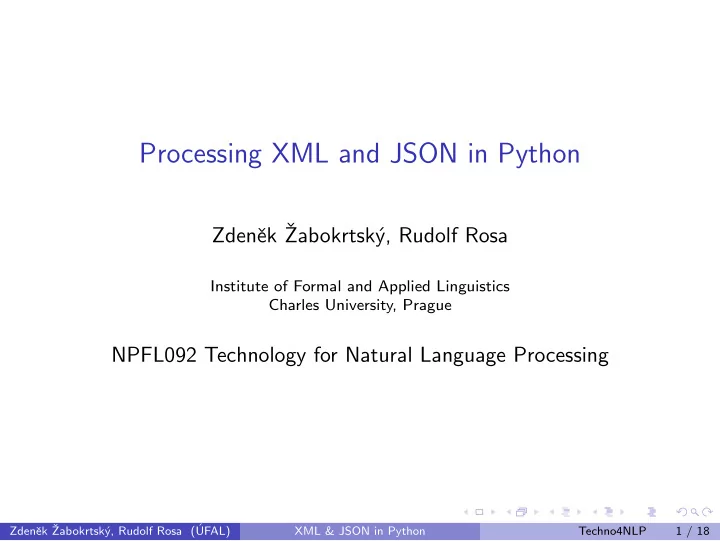

Processing XML and JSON in Python ek ˇ Zdenˇ Zabokrtsk´ y, Rudolf Rosa Institute of Formal and Applied Linguistics Charles University, Prague NPFL092 Technology for Natural Language Processing ek ˇ y, Rudolf Rosa (´ Zdenˇ Zabokrtsk´ UFAL) XML & JSON in Python Techno4NLP 1 / 18
XML in Python the two standard approaches for XML processing are supported in the standard library: ◮ xml.dom.* – a standard DOM API ◮ xml.sax.* – a standard SAX API but there’s a more pythonic API: xml.etree.ElementTree (ET for short) ◮ supports both DOM-like (i.e. all-in-memory) and SAX-like (i.e. event-based, streaming) processing Credit: The following slides are based on an ElementTree intro by Eli Bendersky. ek ˇ y, Rudolf Rosa (´ Zdenˇ Zabokrtsk´ UFAL) XML & JSON in Python Techno4NLP 2 / 18
ET: loading an XML doc import xml.etree.ElementTree as ET tree = ET.ElementTree(file=’sample.xml’) ek ˇ y, Rudolf Rosa (´ Zdenˇ Zabokrtsk´ UFAL) XML & JSON in Python Techno4NLP 3 / 18
ET: traversing the tree root = tree.getroot() for child in root: print(child.tag, child.attrib, child.text) for descendant in root.iter(): .... ek ˇ y, Rudolf Rosa (´ Zdenˇ Zabokrtsk´ UFAL) XML & JSON in Python Techno4NLP 4 / 18
ET: simple searching for elem in tree.iter(tag=’surname’): .... ek ˇ y, Rudolf Rosa (´ Zdenˇ Zabokrtsk´ UFAL) XML & JSON in Python Techno4NLP 5 / 18
ET: complex searching using XPath for elem in tree.iterfind(’*/section/figure[@id="f15"]’): .... ek ˇ y, Rudolf Rosa (´ Zdenˇ Zabokrtsk´ UFAL) XML & JSON in Python Techno4NLP 6 / 18
ET: creating+storing an XML doc root = ET.Element(’root) new elem = ET.SubElement(root, ’data’) tree.ET.ElementTree(root) import sys tree.write(sys.stdout) ek ˇ y, Rudolf Rosa (´ Zdenˇ Zabokrtsk´ UFAL) XML & JSON in Python Techno4NLP 7 / 18
JSON JavaScript Object Notation a simple text-oriented format for data exchange between a browser and a server inspired by JavaScript object literal syntax, but nowadays used well beyond the JavaScript world became one of the most popular data exchange formats in the last years ek ˇ y, Rudolf Rosa (´ Zdenˇ Zabokrtsk´ UFAL) XML & JSON in Python Techno4NLP 8 / 18
XML vs. JSON – a first glimpse <?xml version="1.0"?> { <book id="123"> "id": 123, <title>Object Thinking</title> "title": "Object Thinking", <author>David West</author> "author": "David West", <published> "published": { <by>Microsoft Press</by> "by": "Microsoft Press", <year>2004</year> "year": 2004 </published> } </book> } ek ˇ y, Rudolf Rosa (´ Zdenˇ Zabokrtsk´ UFAL) XML & JSON in Python Techno4NLP 9 / 18
JSON – a quick syntax tour data – hierarchical structures curly braces hold objects ◮ name and value separated by colon ◮ name-value pairs separated by comma square brackets hold arrays ◮ values separated by comma whitespaces (space, tab, LF, CR) around syntactic elements ignored BOM not allowed no syntax for comments ek ˇ y, Rudolf Rosa (´ Zdenˇ Zabokrtsk´ UFAL) XML & JSON in Python Techno4NLP 10 / 18
JSON – data types number string boolean array object null ek ˇ y, Rudolf Rosa (´ Zdenˇ Zabokrtsk´ UFAL) XML & JSON in Python Techno4NLP 11 / 18
JSON in Python json – JSON API in available the standard library API similar to that of pickle ek ˇ y, Rudolf Rosa (´ Zdenˇ Zabokrtsk´ UFAL) XML & JSON in Python Techno4NLP 12 / 18
json : Implicit type conversions A JSON object goes to Python dict a JSON array goes to Python list a JSON string goes to Python unicode a JSON number goes to Python int or long a JSON true goes to Python True etc. and vice versa. ek ˇ y, Rudolf Rosa (´ Zdenˇ Zabokrtsk´ UFAL) XML & JSON in Python Techno4NLP 13 / 18
json : serializing/deserializing import json named entity = {"form":"Bob", "type":"firstname", span:[0,1,2]} serialized = json.dumps(named entity) restored = json.loads(serialized) ek ˇ y, Rudolf Rosa (´ Zdenˇ Zabokrtsk´ UFAL) XML & JSON in Python Techno4NLP 14 / 18
json : selected serialization options There’s some space for customizing the serialization (within the limits given by the JSON spec): encoding – the character encoding (utf-8 by default) indent – pretty-printing with the specified indent level for object members sort keys – output of dictionaries sorted lexicographically by key separator – tuple (item sep, key sep) ek ˇ y, Rudolf Rosa (´ Zdenˇ Zabokrtsk´ UFAL) XML & JSON in Python Techno4NLP 15 / 18
XML vs. JSON – similarities both XML and JSON are frequently used for data interchange both formats are human readable (if designed properly) both are currently supported by many programming languages ek ˇ y, Rudolf Rosa (´ Zdenˇ Zabokrtsk´ UFAL) XML & JSON in Python Techno4NLP 16 / 18
XML vs. JSON – differences as usual, we face the trade-off of simplicity against expressiveness with some over-simplification: JSON is a lightweight cousin of XML JSON is slightly less verbose and simpler (and faster) to parse. . . . . . , but currently there’s more functionality associated with the XML standard: namespaces, referencing, validations schemes, stylesheet transformations, query languages etc. so threre’s no clear superiority of one against the other your final choice should depend on what you really need (and, of course, on the system context) ek ˇ y, Rudolf Rosa (´ Zdenˇ Zabokrtsk´ UFAL) XML & JSON in Python Techno4NLP 17 / 18
XML vs. JSON – can we estimate future from history? In 1990s, XML was introduced as a considerably simplified descendant of SGML. But 20 years later SGML is still everywhere around, incarnated basically in every web page. However, does XML have such a killer app now? ek ˇ y, Rudolf Rosa (´ Zdenˇ Zabokrtsk´ UFAL) XML & JSON in Python Techno4NLP 18 / 18
Recommend
More recommend